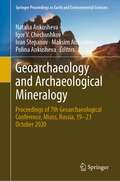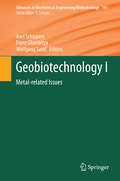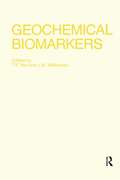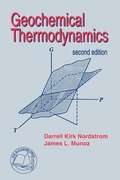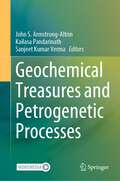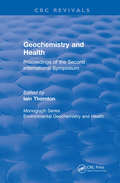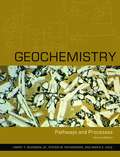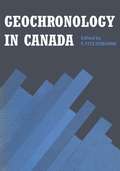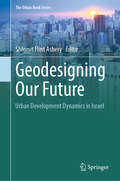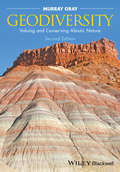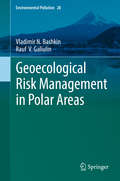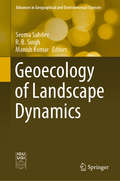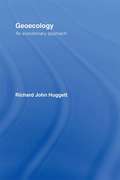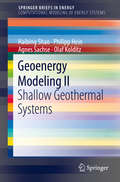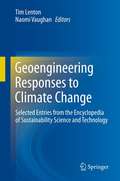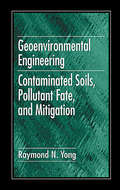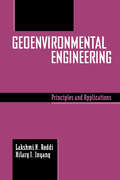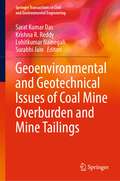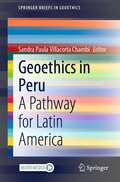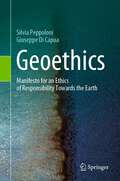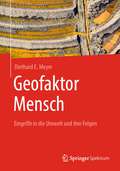- Table View
- List View
Geoarchaeology and Archaeological Mineralogy: Proceedings of 7th Geoarchaeological Conference, Miass, Russia, 19–23 October 2020 (Springer Proceedings in Earth and Environmental Sciences)
by Natalia Ankusheva Maksim Ankushev Igor V. Chechushkov Ivan Stepanov Polina AnkushevaThis book of Springer Proceedings in Geoarchaeology and Archaeological Mineralogy contains selected papers presented at the 7th Geoarchaeology Conference, which took place during October 19–23, 2020, at the South Urals Federal Research Center, Ural Branch of Russian Academy of Sciences, Miass, Russia. The Proceedings combine studies in archeometry, geoarchaeology, and ancient North Eurasian technologies, including paleometallurgy, stone tools investigation, past exploitation of geological resources, bioarchaeology, residue analysis, pottery, and lithics studies. This book also specializes in various non-organic materials, rocks, minerals, ores, and metals, especially copper and metallurgical slags. Many types of research also use modern analytical methods of isotopic, chemical, and mineralogical analysis to address the composition and structure of ancient materials and the technological practices of past human populations of modern Russia, Ukraine, Turkmenistan, Tajikistan, and Mongolia. This book is intended for archaeologists, historians, museum workers, and geologists, as well as students, researchers from other disciplines, and the general public interested in the interdisciplinary research in the field of archaeology and archaeological materials, strategies and techniques of past quarrying, mining, metallurgy and lithic technologies at different chronological periods in Eurasian steppe and adjacent forest zone.
Geobiotechnology II
by Axel Schippers Franz Glombitza Wolfgang SandThis book review series presents current trends in modern biotechnology. The aim is to cover all aspects of this interdisciplinary technology where knowledge, methods and expertise are required from chemistry, biochemistry, microbiology, genetics, chemical engineering and computer science. Volumes are organized topically and provide a comprehensive discussion of developments in the respective field over the past 3-5 years. The series also discusses new discoveries and applications. Special volumes are dedicated to selected topics which focus on new biotechnological products and new processes for their synthesis and purification. In general, special volumes are edited by well-known guest editors. The series editor and publisher will however always be pleased to receive suggestions and supplementary information. Manuscripts are accepted in English.
Geochemical Biomarkers
by T.F. Yen J.M. MoldowanFirst Published in 1988. Routledge is an imprint of Taylor & Francis, an informa company.
Geochemical Rate Models
by J. Donald RimstidtThis well-organised, comprehensive reference and textbook describes rate models developed from fundamental kinetic theory and presents models using consistent terminology and notation. Major topics include rate equations, reactor theory, transition state theory, surface reactivity, advective and diffusive transport, aggregation kinetics, nucleation kinetics and solid-solid transformation rates. The theoretical basis and mathematical derivation of each model is presented in detail and illustrated with worked examples from real-world applications to geochemical problems. The book is also supported by online resources: self-study problems put students' new learning into practice, and spreadsheets provide the full data used in figures and examples, enabling students to manipulate the data for themselves. This is an ideal overview for graduate students, providing a solid understanding of geochemical kinetics. It will also provide researchers and professional geochemists with a valuable reference for solving scientific and engineering problems.
Geochemical Thermodynamics
by Darrell Kirk Nordstron James L. MunozGeochemical Thermodynamics (Second Edition), first published in 1994, takes the reader beyond the fundamental principles of thermodynamics to true geochemical applications. You will find the most complete coverage of the phase rule, chemography, solid solutions, ionic activities in the mixed aqueous electrolytes, and chemical potential diagrams for multiphase systems, plus other concepts central to geochemical theory. Throughout, there is an emphasis on environmentally relevant examples and applications. New sections include: - thermobarometry applications for igneous and metamorphic rocks; -expanding information on electrolytes at high temperature and pressure; - a new chapter on geochemical modeling; and substantially updated and expanded references. - a new appendix containing internally consistent enthalpies, entropies, heat capacities, and free energies, and equilibrium constants for a limited number of elements, ions, non-silicate minerals, and reactions at 298. 15K and 1 atmosphere that are particularly useful for hydrogeochemical modeling. 'This book presents the thermodynamics of geochemical systems, with applications ranging from groundwater to magmas. It should be of interest to a large number of such scientists wishing better acquaintance with the application of thermodynamics to practical problems. Geology There is a good balance of theory and application, and the book is superior to any other available text at the graduate or undergraduate level I can strongly recommend this book, having used it for a third-year undergraduate geochemistry course. It is most appropriate for physical geochemistry course with an emphases on thermodynamics. Researchers in petrology oriented fields will also find the book useful Canadian Mineralogist
Geochemical Treasures and Petrogenetic Processes
by John S. Armstrong-Altrin Kailasa Pandarinath Sanjeet Kumar VermaThis book highlights various aspects of geochemical and geological processes. In brief, it facilitates to understand the geochemical behavior of major, trace and rare earth elements in rocks to identify the magmatic processes involved in present-day magma generation and their relation to global tectonic regimes as well as geothermal studies. Therefore, the book provides a comprehensive view of the generation of magma types (mafic to felsic in composition) and their role in the petrogenesis. The book also covers the development of new geosoftware to effectively process the geochemical data before its interpretation.
Geochemistry and Health: Proceedings of the Second International Symposium (CRC Press Revivals)
by J.N. MartinThis volume comprises the proceedings of a three-day meeting held at the Royal Society, London, UK on 22,23,24 April 1987. The combined second International Symposium on Geochemistry and Health and 5th European Meeting of the Society for Environmental Geochemistry and Health was sponsored by the International Association of Geochemistry and Cosmochemistry, UMESCO, the Society for Environmental Geochemistry and Health and Imperial College with additional finacial supposrt from the UK Department of the Environment, the Royal Society, London and the Southern California Edison Company.
Geochemistry: Concepts and Applications
by Rajender Boddula Tariq Altalhi Inamuddin, Mohd Imran AhamedThis book aims to explore basic principles, concepts and applications of geochemistry. Topics include chemical weathering, impacts on living beings and water, geochemical cycles, oxidation and redox reactions in geochemistry, isotopes, analytical techniques, medicinal, inorganic, marine, atmospheric, and environmental applications, as well as case studies. This book helps in understanding the chemical composition of the earth and its applications. It also includes beneficial effects, bottlenecks, solutions, and future directions in geochemistry.
Geochemistry: Pathways and Processes
by Maria Uhle Harry McSween Steven RichardsonWritten expressly for undergraduate and graduate geologists, this book focuses on how geochemical principles can be used to solve practical problems. The attention to problem-solving reflects the authors'belief that showing how theory is useful in solving real-life problems is vital for learning. The book gives students a thorough grasp of the basic principles of the subject, balancing the traditional equilibrium perspective and the kinetic viewpoint. The first half of the book considers processes in which temperature and pressure are nearly constant. After introductions to the laws of thermodynamics, to fundamental equations for flow and diffusion, and to solution chemistry, these principles are used to investigate diagenesis, weathering, and natural waters. The second half of the book applies thermodynamics and kinetics to systems undergoing changes in temperature and pressure during magmatism and metamorphism. This revised edition incorporates new geochemical discoveries as examples of processes and pathways, with new chapters on mineral structure and bonding and on organic matter and biomarkers. Each chapter has worked problems, and the authors assume that the student has had a year of college-level chemistry and a year of calculus.Praise for the first edition"A truly modern geochemistry book.... Very well written and quite enjoyable to read.... An excellent basic text for graduate level instruction in geochemistry." —Journal of Geological Education"An up-to-date, broadly conceived introduction to geochemistry.... Given the recent flowering of geochemistry as an interdisciplinary science, and given the extent to which it now draws upon the fundamentals of thermodynamics and kinetics to understand earth and planetary processes, this timely and rigorous [book] is welcome indeed." —Geochimica et Cosmochimica Acta
Geochronology in Canada (The Royal Society of Canada Special Publications #No. 8)
by Freleigh OsborneThis volume is made up of papers presented at a colloquium of the Geology Devision of Section III of the Royal Society of Canada at the annual meeting in Quebec, June 1963. The papers fall into two groups: in one group the validity and shortcomings of the methods of establishing the geographical time-table are discussed; and, in the other, applications of the methods to areas across Canada, and from Precambrian to recent, are described. The geological time-table has been built up from the record of the rocks and is based on the law of superposition, a fact that is pointed out in the first paper of this volume. The chronological value of fossils, palaeomagnetism as a means of dating geological events, the limitations of radiometric dating, and other pertinent matters are here dealth with by a group of well-known authorities. These scientific disquisitions will be of great importance to geologists everywhere.This work should be of special interest to those engaged in research on the history of the earth, particularly in relation to the nature, the causes, and the time of an event. It will also serve as a valuable reference to practising geologists in government or industry, to university departments of geology, and to geological consultants. Royal Society of Canada, "Special Publications" Series, no. 8.
Geodesigning Our Future: Urban Development Dynamics in Israel (The Urban Book Series)
by Shlomit Flint AsheryThis book examines how map-based collaboration software can facilitate negotiations in areas undergoing contentious pressures for significant change. Based on case studies from Israel, it aims to introduce a useful model of planning implementation as an outcome of complex interaction to reduce the gap between planning and urban reality. It puts an analytical realist foundation for a productive discussion of the role of future planning and bares meaningful scientific contributions to the general frame of the negotiating process and implementation, which still needs further research and elaboration.Geodesign, a cutting-edge planning approach that is rooted in the history of planning practice, has become one of the most popular approaches for sustainable planning and design activities after 2000s. Planners tend to think of design at a site scale, but geodesign covers a variety of scales, bridging the gap between the regional and the local contexts.This is important because to be practically effective and politically prudent, "smart growth" plans need to make sense across a spectrum of scales and disciplines. This ranges from design, urban design, community planning, town and city planning, and regional planning, up to planning for mega-regions.
Geodiversity
by Murray GrayThe first book to focus exclusively on the subject, Geodiversity, Second Edition describes the interrelationships between geodiversity and biodiversity, the value of geodiversity to society, as well as current threats to its existence. Illustrated with global case studies throughout, the book examines traditional approaches to protecting geodiversity and the new management agenda now being implemented. The Second Edition of this successful textbook continues to build on the success of the first edition which is still the standard reference for the subject.Fully revised and updated throughout, the Second Edition now includes new material on geoparks, geotourism and implications of climate change for geoconservation.Reviews of previous edition:"Murray Gray's new book is the first widely available text to bring together and analyse some of these emerging ideas....The result is a book that should be in the library of every land manager and one that is likely to lead many practicing geoscientists and quaternarists to a new view of the importance of their field for nature conservation and environmental management... (Journal of Quaternary Science, Vol.19, No.8, December 2004) "It is strange that it is necessary to justify the importance of geodiversity.... Murray Gray does it with brilliance, not only to convince 'non-believers', but giving inspiration to us that have worked in geoconservation for a long time" (ProGEO News, 3 & 4, 2003) "...The author provides a timely review of recent advances in the integration of geodiversity into wider conservation and planning strategies..." ...." (Journal of Quaternary Science, Vol.19, No.8, December 2004) "...the book is well-written and follows a clear and concise outline." (Environmental Geology, Vol. 48, No. 2, July 2005)
Geoecological Risk Management in Polar Areas (Environmental Pollution #28)
by Vladimir N. Bashkin Rauf V. GaliulinThis monograph is devoted to full-scale geoecological risk assessment in gas industry impacted polar areas and the relevant risk management options using innovative nature-like biogeochemical technologies. Readers will discover more about geoecological risks during gas production, transportation, storage and refining. Chapters discuss in detail the geodynamic dangers associated with the designing and building of main gas pipelines. The book has interdisciplinary appeal, and specialists and practitioners in environmental sciences, ecology, biogeochemistry and those within the energy sector who are interested in understanding ecosystems affected by anthropogenic impacts in severe climatic conditions will find it particularly engaging. Through this book, readers will learn more about recultivation of contaminated soils as well as health risk assessments of chemical substances associated with the gas industry.
Geoecology of Landscape Dynamics (Advances in Geographical and Environmental Sciences)
by R. B. Singh Manish Kumar Seema SahdevThis book provides an overview of the ecological indicators of landscape dynamics in the context of geographical landscape integration. Landscape dynamics depicts every change that occurs in the physical, biological, and cognitive assets of a landscape. To understand and interpret the complex physical, biological, and cognitive phenomena of landscapes, it is necessary to operate conceptually and practically on a broad range of spatial and temporal scales. Rapid land use changes have become a concern to environmentalists and planners because of their impacts on the natural ecosystem, which further determines socioeconomic dynamics. In this regard, the book discusses case studies that share new insights into how landscape patterns and processes impact small creatures, and how small creatures in turn influence landscape structure and composition. In turn, the relevant aspects of land use and land cover dynamics are covered, and the multi-faceted relationship between the substrata and ecological community is highlighted. The book is unique in its focus on the application of spatial informatics such as automatic building extraction from high-resolution imagery; a soil resource inventory for meeting the challenges of land degradation; hydrological modeling; the temporal variation analysis of glacier area and the identification and mapping of glacial lakes; morphometric analysis of river basins; and the monitoring and modeling of urban sprawl, among other features.
Geoecology: An Evolutionary Approach
by Richard HuggettAnimals, plants and soils interact with one another, with the terrestrial spheres, and with the rest of the Cosmos. On land, this rich interaction creates landscape systems or geoecosystems. Geoecology investigates the structure and function of geoecosystems, their components and their environment. The author develops a simple dynamic systems model, the `brash' equation, to form the conceptual framework for the book suggesting an `ecological' and `evolutionary' approach. Exploring internal of `ecological' interactions between geoecosystems and their near-surface environments - the atmosphere, hydrosphere, toposhere, and lithosphere - and external influences, both geological and cosmic, Geoecology presents geoecosystems as dynamic entities constantly responding to changes within themselves and their surroundings. An `evolutionary' view emerges of geoecological systems, and the animals, plants, and soils comprising them, providing a new way of thinking for the whole environmental complex and the rich web of interdependencies contained therein.
Geoenergy Modeling II
by Olaf Kolditz Agnes Sachse Haibing Shao Philipp HeinThis book is dedicated to the numerical modeling of shallow geothermal systems. The utilization of shallow geothermal energy involves the integration of multiple Borehole Heat Exchangers (BHE) with Ground Source Heat Pump (GSHP) systems to provide heating and cooling. The modeling practices explained in this book can improve the efficiency of these increasingly common systems. The book begins by explaining the basic theory of heat transport processes in man-made as well as natural media. . These techniques are then applied to the simulation of borehole heat exchangers and their interaction with the surrounding soil. The numerical and analytical models are verified against analytical solutions and measured data from a Thermal Response Test, and finally, a real test site is analyzed through the model and discussed with regard to BHE and GSHP system design and optimization.
Geoengineering Responses to Climate Change
by Naomi Vaughan Tim LentonFailure by the international community to make substantive progress in reducing CO2 emissions, coupled with recent evidence of accelerating climate change, has brought increasing urgency to the search for additional remediation approaches. This book presents a selection of state-of-the-art geoengineering methods for deliberately reducing the effects of anthropogenic climate change, either by actively removing greenhouse gases from the atmosphere or by decreasing the amount of sunlight absorbed at the Earth's surface. These methods contrast with more conventional mitigation approaches which focus on reducing emissions of greenhouse gases, especially carbon dioxide. Geoengineering technologies could become a key tool to be used in conjunction with emissions reduction to limit the magnitude of climate change. Featuring authoritative, peer-reviewed entries from the Encyclopedia of Sustainability Science and Technology, this book presents a wide range of climate change remediation technologies.
Geoenvironmental Engineering: Contaminated Soils, Pollutant Fate, and Mitigation
by Raymond N. YongGeoenvironmental Engineering: Contaminated Soils, Pollutant Fate, and Mitigation focuses on why soils and sediments remain contaminated. The reader will understand why specific contaminants remain in soils and sediments, how much of a threat they pose to human health and the environment, and what steps to take for mitigation. Subjects covered include the basic properties of soils affecting accumulation of contaminants, long-term retention of contaminants and their fate, including the development of intermediate products. The author emphasizes the factors, interactions, and mechanisms important in the bonding and partitioning process.
Geoenvironmental Engineering: Principles and Applications
by Hilary I. Inyang Lakshmi ReddiApplies science and engineering principles to the analysis, design, and implementation of technical schemes to characterize, treat, modify, and reuse/store waste and contaminated media. Includes site remediation.
Geoenvironmental Engineering: Proceedings of EGRWSE-23, Volume 1 (Lecture Notes in Civil Engineering #508)
by Krishna R. Reddy Arvind Kumar Agnihotri Ajay BansalThis book contains peer-reviewed and selected papers presented during the International Conference on Environmental Geotechnology, Recycled Waste Materials and Sustainable Engineering (EGRWSE) 2023, held at NIT Jalandhar. It discusses the recent innovations, trends, concerns, practical challenges encountered, and the solutions adopted in waste management and engineering, geotechnical and geoenvironmental engineering, infrastructure engineering and sustainable engineering. This book can serve as a useful resource for researchers, educators, policymakers, and professionals working in the field of civil engineering, chemical engineering, environmental sciences, and public policy.
Geoenvironmental and Geotechnical Issues of Coal Mine Overburden and Mine Tailings (Springer Transactions in Civil and Environmental Engineering)
by Krishna R. Reddy Sarat Kumar Das Lohitkumar Nainegali Surabhi JainThis contributed book edited by leading global experts focuses on the geoenvironmental and geotechnical issues of coal mine overburden and mine tailings and its unengineered dumping. It aims to provide knowledge-based information for diverse readers to assess, monitor, and manage coal mine overburden and mine tailings in various engineering applications while highlighting efficient solutions to reutilize the waste and conserve natural resources leading to sustainable development. The content also assesses mine backfilling, techniques to stabilize mine tailing storage facilities, mineral carbonation of mine tailings, landfill liners and barrier systems, reclamation of coal mine overburden, and geochemical, microbial, and environmental sustainability assessment, among others. This book is a useful resource for those in academia and industry.
Geoethics in Peru: A Pathway for Latin America (SpringerBriefs in Geoethics)
by Sandra Paula Villacorta ChambiThe book discusses geoscience issues in Peru from a geoethical perspective, based on the leading experience of the Peruvian section of the International Association for Promoting Geoethics, in its seven years of activity.The introduction will present past and current activities to promote geoethics in Peru, such as the organization of the MinerLima exhibition (that has teaching purposes); the implementation of geoethics in georisk communication with vulnerable populations, as well as the promotion of adequate knowledge about national geological heritage. The other chapters will describe the main geoethical issues in Peru, related to georisk management and communication, mining, paleontology and geoheritage, geoducation. Some proposals for actions that should be taken to improve societal awareness and to make progress in problem-solving from a geoethical perspective will be discussed for each issue.In the final chapter Peruvian geoescience implications and new roles for geoscientists will be discussed, providing clues to their participation in the management of socio-environmental problems that affect Latin American region. It will be also underlined how geoethics represents a new theoretical and practical approach that may contribute in the current process to modernize geoscience education in Latin America.In this sense, this publication provides a solid base to apply the theoretical framework of Geoethics in Peru that may be suggested as an example to promote geoethics in other Latin American countries. As a result, the need to inform and prepare the population of growing countries such as Peru to face the problems of the modern world is evident.In order to attract more readers in Latin America, each chapter will be provided with a summary in Spanish.
Geoethics: Manifesto for an Ethics of Responsibility Towards the Earth
by Silvia Peppoloni Giuseppe Di CapuaThis book outlines the current development of geoethical thinking, proposing to the general public reflections and categories useful for understanding the ethical, cultural, and societal dimensions of anthropogenic global changes. Geoethics identifies and orients responsible behaviors and actions in the management of natural processes, redefining the human interaction with the Earth system based on a critical, scientifically grounded, and pragmatic approach. Solid scientific knowledge and a philosophical reference framework are crucial to face the current ecological disruption. The scientific perspective must be structured to help different human contexts while respecting social and cultural diversity. It is impossible to respond to global problems with disconnected local actions, which cannot be proposed as standard and effective operational models. Geoethics tries to overcome this fragmentation, presenting Earth sciences as the foundation of responsible human action toward the planet. Geoethics is conceived as a rational and multidisciplinary language that can bind and concretely support the international community, engaged in resolving global environmental imbalances and complex challenges, which have no national, cultural, or religious boundaries that require shared governance. Geoethics is proposed as a new reading key to rethinking the Earth as a system of complex relationships, in which the human being is an integral part of natural interactions.
Geofaktor Mensch: Eingriffe in die Umwelt und ihre Folgen
by Diethard E. Meyer„Lässt sich die Erde retten? Sicherlich nicht mit einem neuen Buch wie diesem - aber es kann helfen, die Umweltprobleme besser zu verstehen!“ Der Aufstieg des Menschen zur wirksamsten geologischen Kraft auf dem Planeten Erde - kurz „Geofaktor Mensch“ genannt - vollzog sich allmählich. Im Industriezeitalter steigerte sich diese Kraft enorm durch neue Techniken. Diese ermöglichten die Inanspruchnahme fast sämtlicher Georessourcen für eine obendrein dramatisch anwachsende Menschheit, die weiterhin weltweit nach einem höheren Lebensstandard strebt. Kaum ein Gebiet der Erde bleibt verschont. Diese anthropogenen Eingriffe in das Naturgeschehen sind in vielfacher Hinsicht einzigartig - sowohl in ihrem Umfang als auch in ihrer Qualität. Seit kurzem wird dieser neuartige Zeitabschnitt in der Geschichte unseres Planeten als das „Anthropozän“ bezeichnet. Anschaulich und mit vielen Fotos und Diagrammen belegt dieses Werk das teilweise höchst komplexe Zusammenspiel der menschlichen Eingriffe in Natur und Umwelt. Zunächst schleichend, dann aber sehr plötzlich kann dieses an bestimmten „Kipp-Punkten“ zu anthropogen induzierten Katastrophen führen. Und genau diese gilt es von vornherein durch wissenschaftlich fundierte Planung unter strikter Kontrolle bei sich verändernden Rahmenbedingungen zu verhindern. Für Geowissenschaftler, Ökologen, Ingenieure und Landschaftsarchitekten sowie alle Tätigen in der Landschaftsplanung oder im Umwelt- und Naturschutz und nicht zuletzt die Entscheidungsträger in Politik und Wirtschaft vermittelt Geofaktor Mensch über das Orientierungswissen hinaus ein tieferes Verständnis der geologischen und ökologischen Prozesse. Diese zu kennen ist Voraussetzung für eine verlässliche Beurteilung des Systems der belebten Erde - der Geobiosphäre. Die zahlreichen Literaturhinweise ermöglichen eine gezielte Vertiefung der einzelnen Themen, besonders auch für Studierende.
Geoforming Mars: How could nature have made Mars more like Earth?
by Robert MalcuitThis book offers an exercise in theoretical planetology, presenting five different scenarios to assess the evolution of habitable conditions on Mars to assess planetary terraforming potential and to give insight into the ongoing search for habitable exoplanets. Four of the scenarios involve Martian satellite capture models, in which gravitational capture via tidal deformation and energy dissipation processes are measured to predict a pathway of biological evolution, while the fifth scenario analyzes the possible model that led to the Mars that we have today (i.e. with no life forms). In ten chapters, readers will learn how a Mars-like terrestrial planet can be transformed into a habitable planet, and what conditions must be assessed when searching for exoplanets in a star-centered orbit to support life. The book is intended for planetologists, and general enthusiasts of planetary evolution and our solar system.
